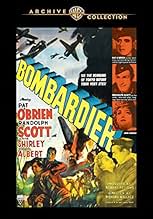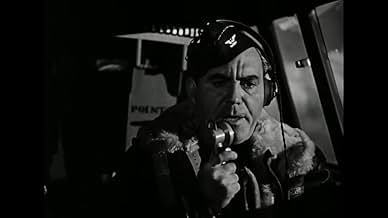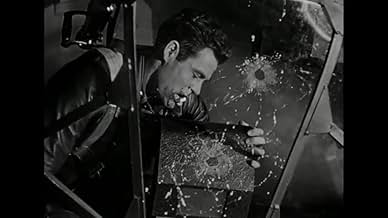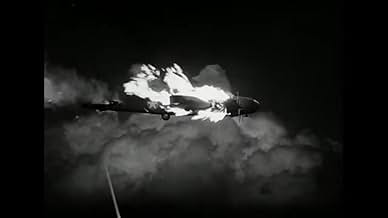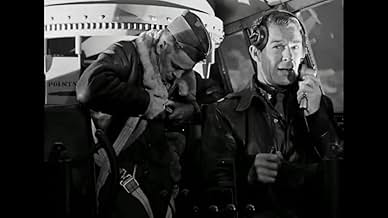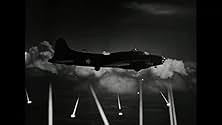O Major Davis está convencido de que os bombardeios de alto nível vencerão a próxima guerra. Ele convence os poderes de estabelecer uma escola de bombardeiros e treina a primeira geração de ... Ler tudoO Major Davis está convencido de que os bombardeios de alto nível vencerão a próxima guerra. Ele convence os poderes de estabelecer uma escola de bombardeiros e treina a primeira geração de bombardeiros de alto nível da USAAF.O Major Davis está convencido de que os bombardeios de alto nível vencerão a próxima guerra. Ele convence os poderes de estabelecer uma escola de bombardeiros e treina a primeira geração de bombardeiros de alto nível da USAAF.
- Direção
- Roteiristas
- Artistas
- Indicado a 1 Oscar
- 1 vitória e 1 indicação no total
Eugene L. Eubank
- General Eubank
- (as Brigadier-General Eugene L. Eubank)
Murray Alper
- Little Boy - Spy
- (não creditado)
Stanley Andrews
- Congressman
- (não creditado)
Joan Barclay
- Buck's Secretary
- (não creditado)
Hugh Beaumont
- Soldier
- (não creditado)
Avaliações em destaque
Pat O'Brien takes his Knute Rockne character and joins the Army Air Corps in Bombardier and he and Randolph Scott have a disagreement as far as air tactics go. Scott wants to do things as they do in the RAF where he's been an observer. Fly in low and drop bombs and avoid being shot at.
O'Brien is more interested in technology. Develop and learn how to use an accurate bombsight so you can be up around 20,000 feet and only have to worry about enemy planes which presumably your fighter escort has to deal with.
But since these guys are friends it's a good natured fight as both are in the business of training bombardiers. Among the familiar faces they train are Eddie Albert and Robert Ryan before both went in the service themselves.
Bombardier is so very dated now, but still entertaining. The advances in technology are light years beyond what O'Brien and Scott are dealing with. Film buffs who are air historians might like it though.
O'Brien is more interested in technology. Develop and learn how to use an accurate bombsight so you can be up around 20,000 feet and only have to worry about enemy planes which presumably your fighter escort has to deal with.
But since these guys are friends it's a good natured fight as both are in the business of training bombardiers. Among the familiar faces they train are Eddie Albert and Robert Ryan before both went in the service themselves.
Bombardier is so very dated now, but still entertaining. The advances in technology are light years beyond what O'Brien and Scott are dealing with. Film buffs who are air historians might like it though.
Richard Martin first played Chito Rafferty in this movie World War 2 movie. He would go on to play that same character 32 times, mostly in Tim Holt Westerns, but he did play it twice along side Robert Mitchem in Nevada and West of the Pecos. The Chito Rafferty character also appeared alongside James Warren in Wanderer of the Wasteland. One wonders how a character that first appeared in a modern war flick ended up being a longtime sidekick in Westerns. Interestingly, the second time Martin played his famous character was not with Tim Holt, but with Robert Mitchum in Nevada. It would not be until 1947, that the Rafferty character appeared alongside cowboy star Tim Holt in Wild Horse Mesa.
Made in 1942, before the allies had the upper-hand in Europe, 'Bombardier' is part entertainment, part propaganda, and part recruiting film. The film follows the establishment of a Bombardier Training School, championed by Major "Chick" Davis (Pat O'Brien), a firm believer in high-altitude precision bombing and criticized by his buddy, Capt. "Buck" Oliver (Randolph Scott), a pilot-oriented proponent of low-level drops and dive-bombing. As the film opens with (the real) Brigadier General Eugene L. Eubank extolling the critical role of the bombardier in the ongoing war, there is little doubt which of the two offensive strategies is going to win out. Typical of the genre, the film follows a diverse group of trainees, from their arrival at the school to their baptisms in fire, with some romantic filler and dated comic-relief thrown in. Even by wartime standards, the film is pretty heavy handed. There is a particularly egregious sequence in which a trainee admits that he is uncomfortable with dropping high-explosives on targets where there may be non-combatants (including women) and that his mother had written him a letter expressing her concerns that he was training to be a murderer. The chaplain explains to him (and indirectly to the audience, which might include people of similar opinions to the fictional mother), that the bombardier is doing God's will by bombing the German military-industrial infrastructure. During the war Americans celebrated "Rosie the Riveter", who represented the women who worked in the factories thereby freeing-up men to fight, and as there would be no reason to believe that women in the Axis powers weren't doing the same, people must have accepted the fact that women could be killed when the factories were bombed (as were, as was later discovered, forced laborers). The film contains is lots of great aircraft footage, especially of the Douglas B-18 Bolo (which would have been obsolete when the film came out) and of the iconic B17 'Flying Fortress'. I particularly liked the well-done special-effects footage of Japanese fighters attacking a formation of five B17s, which bring the massive firepower of their dozens of .50 calibre machineguns to bear, annihilating the attacking fighters. This prodigious defensive firepower gave the plane its nickname but in reality was not sufficient to ward off attacks by faster and more nimble fighters (as the USAF found out at great cost over Germany in 1943). The rest of the special effects are hit and miss, there are some good pyrotechnic scenes as the bombs bullseye Japanese targets but the earlier B18 model work is substandard, even for the times. The cast is fine in what is essentially a propaganda picture, there are lots of gorgeous, soldier-loving, dames to entice young men in the audience to sign-up, and a thrilling but typically far-fetched heroic climax. OK for an unsubtle WW2 morale-booster/recruitment film (especially if you like planes) but not in the same league as the excellent "30 Seconds over Tokyo" (1944).
I saw this movie in the late 1950's or early 1960's on TV and it has always stuck with me. The scene that stands out vividly is when Robert Ryan walks into the church and yells, "The Japs just bombed Pearl Harbor". That scene has stuck in my head over 50 years. Oddly it seems that the ending involves bombing Nagoya. The movie went from Japanese bombing Pearl Harbor to the U.S. bombing the Japanese homeland really quickly. Another interesting thing is the movie never uses the word Norton Bombsight. At the time of the movie, even the word Norton was secret. Also, you never see the actual bomb sight only something being carried in a cloth bag by two airmen. Even a picture of the sight was secret. I did like the picture because it shows the training the men received. It seems like a lot of training just to push a button. I also like of part of the Bombardier controlling the plane. The part of the movie seems right in that the plane, pilot, ground crew, and everything else is there just to take the Bombardier to the target so he can push a button. The Pilot and Bombardier is like playing golf. The drive is for the show (pilot) but the putt (bombardier) is for the dough!. The rest was over the top--the oath and song of the Bombardier. Lastly, wasn't the actor who played the Japanese officer also played "Harry Hoo" on the TV show "Get Smart". All in all a film worth watching.
This 1943 film by RKO is among several that Hollywood and/or the War Department put out during the early months and years of World War II. It's a mix of genres. The war action comes at the end. A docu-drama style tells the story of the bombardier school and training. Hollywood adds its usual touch of romance, but lightly. The drama is there – even in the training. And, of course, it's a propaganda film. Propaganda surely had its place in WWII – to help sustain public morale, build support for the U.S. cause and efforts, and give the public a picture of some of the troops, training, and campaigns.
"Bombardier" tells and shows us the early days of training for this new position in the Army Air Forces – precursor of the U.S. Air Force. As such, it's a good educational piece for the public, then and now. The men who went into combat in different roles weren't tossed together and sent into combat. They were trained first. And for some fields, the training was highly specialized and detailed. This film shows very well that detail, study and science that went into the training of bombardiers. These men indeed played a critical role in destroying enemy armament production, fuel depots and major supplies – and in so doing, helped end the war much earlier than it would have otherwise concluded.
Many have said it since the first attribution to Civil War Gen. William T. Sherman, that "War is hell!" But once a nation is in a war, it should do everything possible to end it as soon as possible.
Many war movies have been made, especially about the two "great" world wars of the 20th century. They have variously focused on the action of troops in battles, assaults from the sea, naval engagements or air combat. Most give us a picture, however much Hollywood may "tweak" it, of the human conditions, relationships, and characters. Often times they include the strategic plans of real battle scenes. These are the things that most interest people, or "entertain" audiences for this genre. But films such as "Bombardier" add another value in educating and informing the public of what went into the readying of our nation for war, and our ability to win and end it as soon as possible.
As an Army paratrooper veteran, I enjoy learning about the "how-to" that men and women learn in the different combat and support specialties of our armed services. People who approach war movies in a similar frame of mind will be much more likely to enjoy them. I highly recommend "Bombardier" as an informative, action-filled and historical war movie.
"Bombardier" tells and shows us the early days of training for this new position in the Army Air Forces – precursor of the U.S. Air Force. As such, it's a good educational piece for the public, then and now. The men who went into combat in different roles weren't tossed together and sent into combat. They were trained first. And for some fields, the training was highly specialized and detailed. This film shows very well that detail, study and science that went into the training of bombardiers. These men indeed played a critical role in destroying enemy armament production, fuel depots and major supplies – and in so doing, helped end the war much earlier than it would have otherwise concluded.
Many have said it since the first attribution to Civil War Gen. William T. Sherman, that "War is hell!" But once a nation is in a war, it should do everything possible to end it as soon as possible.
Many war movies have been made, especially about the two "great" world wars of the 20th century. They have variously focused on the action of troops in battles, assaults from the sea, naval engagements or air combat. Most give us a picture, however much Hollywood may "tweak" it, of the human conditions, relationships, and characters. Often times they include the strategic plans of real battle scenes. These are the things that most interest people, or "entertain" audiences for this genre. But films such as "Bombardier" add another value in educating and informing the public of what went into the readying of our nation for war, and our ability to win and end it as soon as possible.
As an Army paratrooper veteran, I enjoy learning about the "how-to" that men and women learn in the different combat and support specialties of our armed services. People who approach war movies in a similar frame of mind will be much more likely to enjoy them. I highly recommend "Bombardier" as an informative, action-filled and historical war movie.
Você sabia?
- CuriosidadesThe American bomb sight mentioned throughout the movie was the Norden bomb sight whose secret was almost as closely guarded as the development of the atomic bomb. It used a mechanical computer and linkage to the plane's autopilot to achieve an accuracy of hitting with 75 feet of the target from an altitude of 12000 feet. All members of the bomber's crew were ordered to destroy the sight at all costs if the plane was going to crash. Many ships carried a hand grenade to place under the sight to assure total destruction. It was used as late as 1967 to drop sensors along the Ho Chi Minh trail in Viet Nam.
- Erros de gravaçãoThe Douglas B18's, Beechcraft AT11's and B17 aircraft all sport national markings found from May 1942 until June 1943, yet a considerable part of this film takes place before Pearl Harbor.
- Citações
Burton Hughes: You're quite an entomologist.
Sgt. Archie Dixon: Nope! But I know all about bugs.
- Cenas durante ou pós-créditosBrigadier General Eugene L. Eubank is billed first because he is credited in the forward before any cast is mentioned, and he is not listed in the comprehensive end credits.
- Versões alternativasAlso available in a computer colorized version.
- ConexõesReferences Adeus, Mr. Chips (1939)
- Trilhas sonorasSong of the Bombardiers
(1942) (published title)
On-screen title: "Song of the U. S. Bombardiers"
Music by M.K. Jerome (as M. K. Jerome)
Lyrics by Jack Scholl
Played during the opening and closing credits and often in the score
Sung by the audience at the magic show
Principais escolhas
Faça login para avaliar e ver a lista de recomendações personalizadas
Detalhes
- Tempo de duração
- 1 h 39 min(99 min)
- Cor
- Proporção
- 1.37 : 1
Contribua para esta página
Sugerir uma alteração ou adicionar conteúdo ausente


